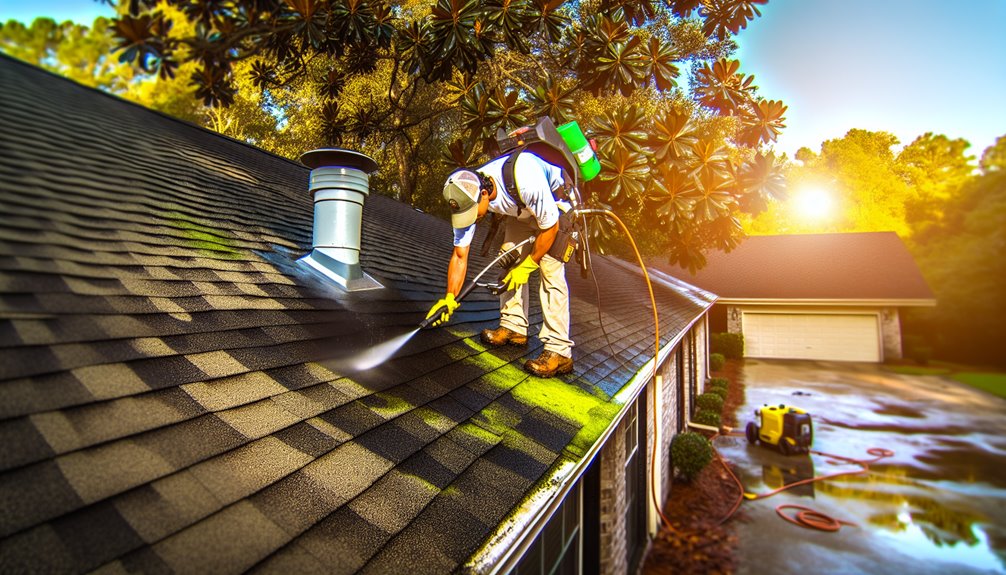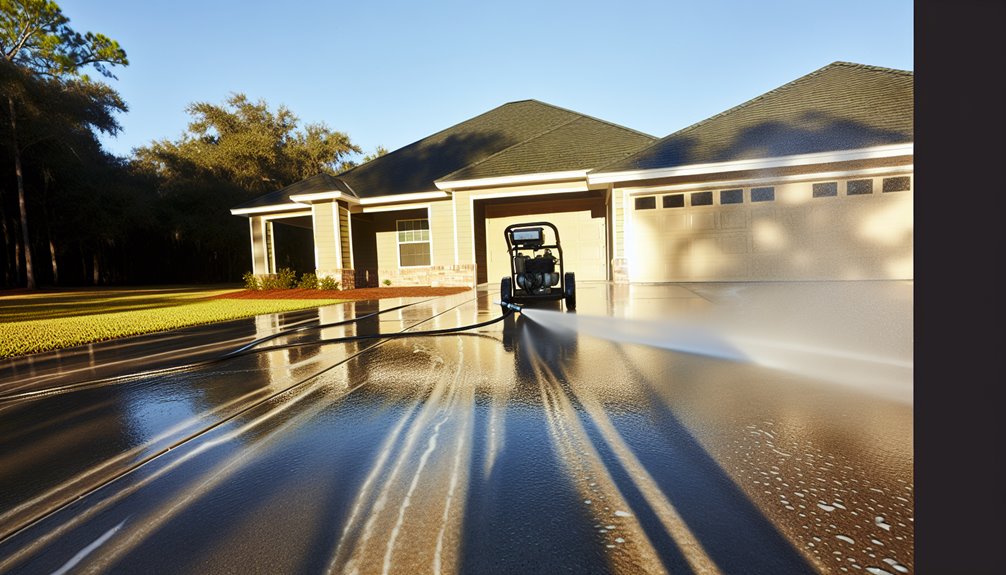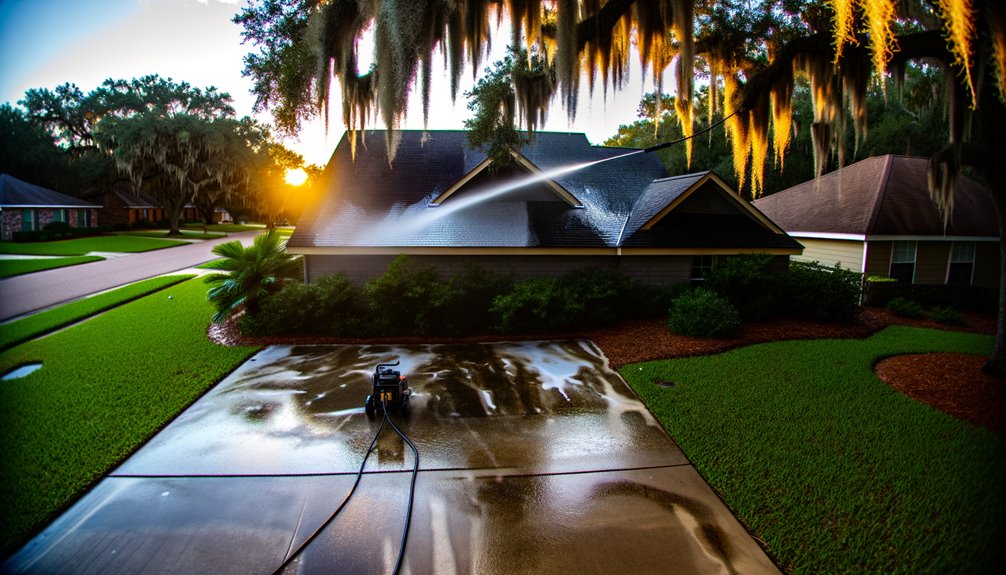In coastal Mississippi, 70% of roofs show visible algae within three years due to Gulf humidity and salt drift. You can reverse that trend with calibrated soft-wash on shingles, gutter-safe brightening agents, and controlled pressure or rotary cleaners on concrete. You’ll pre-wet plants, manage runoff, and adjust dwell times for muggy mornings to avoid damage. Done right, you protect landscaping, extend material life, and restore curb appeal—yet one step determines whether you clean or cause costly harm.
Understanding South Mississippi’s Climate and Its Impact on Exterior Surfaces

Because South Mississippi sits in a humid subtropical zone with high rainfall, long summers, and mild winters, exterior surfaces here face rapid bio-growth and material stress. You contend with warm Gulf winds, salt air, and shifting humidity patterns that feed algae, mildew, and lichen on roofs, gutters, and driveways. UV exposure dries sealants; daily dew cycles re-wet pores, accelerating expansion, contraction, and spalling. Clay-rich soils splash fines onto lower walls and concrete, embedding stains. You’ll protect clients’ assets by scheduling routine rinses, clearing debris paths, and monitoring drainage. Target shaded orientations, drip lines, and coastal exposures first. Document conditions and adjust maintenance frequency seasonally.
Soft-Wash vs. High-Pressure: Choosing the Right Method for Each Surface
Even with stubborn Gulf Coast grime, you shouldn’t treat every surface the same—match soft-wash chemistry or high-pressure mechanics to the substrate, soil load, and exposure. You’ll protect paint, seals, and mortar while restoring sheen fast. Use low pressure detergents on siding, stucco, and oxidized metals; reserve high-pressure for dense concrete or paver joints with compacted mud.
- Assess porosity, age, and coating: vinyl/stucco prefer 100–300 PSI with low pressure detergents; concrete tolerates higher PSI with rotary nozzles.
- Control foam application timing for humid, breezy Bay St. Louis mornings; extend dwell, avoid flash-drying.
- Rinse to municipal stormwater standards; neutralize runoff near plantings.
Roof Cleaning: Removing Algae Safely and Preserving Shingles

You matched wash method to each façade; now apply that same discipline up top, where Gulf air feeds Gloeocapsa magma streaks and lichens on asphalt shingles. Use a calibrated soft-wash: low PSI, fan tip, and a metered sodium hypochlorite blend buffered with surfactant and rinsing aid. Pre-wet plants, control runoff, then treat from ridge to eave. Allow proper dwell, keep shingles cool, and rinse to neutral. Install zinc or copper strips for ongoing algae inhibitors. Avoid wand abrasion and granular loss; never pressure-cut edges or lift tabs. Verify attic ventilation and sun exposure. Document shingle preservation with before/after photos and warranty-safe procedures.
Gutter Washing and Brightening: Clearing Debris and Preventing Water Damage
When summer downpours hammer the Coast and pine pollen cakes every surface, clean and brighten gutters to keep fascia dry and foundations out of harm’s way. You’ll clear roofline channels, flush leaders, and neutralize tiger-striping. Use low-pressure rinsing, a gutter-safe surfactant, and soft-bristle agitation. Follow with a whitening agent calibrated for aluminum or coated steel. Verify slope and secure hangers. Schedule downspout inspection and test flow to daylight. Install or service leaf guards to limit rework and protect service visits.
- Select chemistry: sodium percarbonate clean; oxalic brighten
- Flush: top-down, then bottom-up verification
- Document: joints, sealant, fasteners, splash blocks
Driveway and Concrete Restoration: Lifting Mold, Mildew, and Stains for Lasting Curb Appeal

Along the Gulf’s humid edge, restore driveways and flatwork with calibrated pressure, targeted chemistry, and controlled dwell. You’ll pre-wet edges, protect landscaping, and apply metered chemical treatments to break down mold, mildew, rust, and tannin stains common in South Mississippi. Use a rotary surface cleaner for uniform passes, then edge-rinse to evacuate slurry toward proper drainage. Adjust PSI and nozzle angle to avoid etching older concrete. Neutralize, then post-treat with a mildewcide to delay regrowth. After curing, apply breathable surface sealing to lock out moisture and contaminants. You’ll deliver safer footing, brighter concrete, and longer intervals between maintenance.
Conclusion
At Hydra Clean, I take pride in bringing out the best in your home’s exterior, just like the refreshing Gulf breeze that sweeps through our beautiful South Mississippi. I’m passionate about restoring your curb appeal while ensuring the safety of your surfaces and the longevity of your materials. If you’re ready to see your home shine again, I invite you to visit myhydraclean.com or give me a call at (601) 336-2411. Let’s work together to make your home the envy of the neighborhood!

